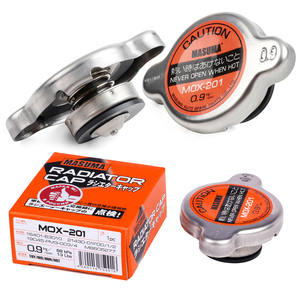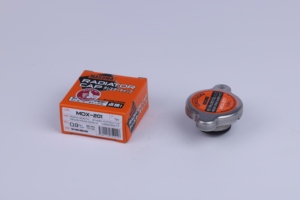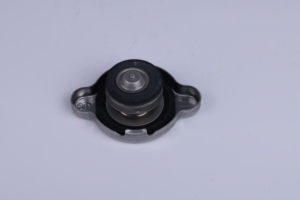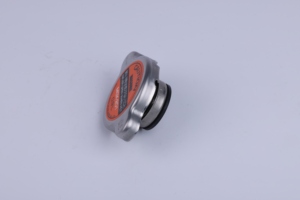Types of PA66 GF30 Radiator Caps
The PA66 GF30 radiator cap is a critical component in your vehicle's cooling system, maintaining proper pressure and preventing coolant loss. Available in various designs to suit different vehicles and cooling systems, these caps are engineered with PA66 GF30 material - a glass fiber reinforced nylon known for its exceptional heat resistance and durability.
Spring-Loaded Caps
These caps utilize a spring mechanism that creates optimal pressure on the seal when closed, ensuring the radiator system remains tightly sealed during operation.
Key benefit: Requires minimal effort to open while maintaining excellent sealing properties
Twist-Release Caps
Featuring a series of notches or locking mechanisms, these caps require a twisting motion to release and remove, providing an additional safety layer against accidental opening.
Key benefit: Enhanced security prevents unexpected pressure release
Lever-Action Caps
Utilizing a lever mechanism for opening and closing, these caps allow for rapid access to the radiator system when needed while maintaining a secure seal.
Key benefit: Ideal for heavy-duty vehicles and extreme operating conditions
Vacuum-Pressure Caps
These specialized caps maintain both vacuum and pressure in the cooling system, creating optimal conditions for coolant circulation and heat distribution.
Key benefit: Improves cooling system efficiency and prevents coolant loss
Safety Release Caps
Engineered with a gradual release mechanism, these caps safely vent excess pressure without the dangerous sudden release of steam or hot coolant.
Key benefit: Minimizes burn risk and prevents radiator damage from overpressure
Expert Tip: When replacing your radiator cap, always match the pressure rating to your vehicle manufacturer's specifications. Using a cap with incorrect pressure rating can lead to cooling system inefficiency or even damage to your engine.
| Cap Type | Best Application | Main Advantages | Safety Features |
|---|---|---|---|
| Spring-Loaded | Standard passenger vehicles | Ease of use, reliable sealing | Controlled pressure release |
| Twist-Release | Family vehicles, safety-focused applications | Enhanced security, accident prevention | Two-stage opening process |
| Lever-Action | Heavy-duty and commercial vehicles | Quick access, durable construction | Secure locking mechanism |
| Vacuum-Pressure | Performance vehicles, high-temperature applications | Optimal cooling efficiency, reduced coolant loss | Dual-function pressure regulation |
| Safety Release | All vehicles, especially hot climate regions | Gradual pressure release, enhanced safety | Anti-scald design, controlled venting |
Specifications and Maintenance of PA66 GF30 Radiator Caps
Understanding the technical specifications of your radiator cap is essential for ensuring proper cooling system performance and vehicle safety. The PA66 GF30 material offers superior heat resistance and durability compared to standard plastics, making it ideal for this critical component.
Pressure Rating
Measured in pounds per square inch (PSI), this specification indicates the maximum pressure the cap can maintain. Common ratings range from 13-16 PSI for passenger vehicles, with heavy-duty applications requiring higher ratings up to 20+ PSI.
Higher pressure ratings increase the coolant's boiling point, enhancing heat absorption capacity and cooling efficiency.
Size and Fitment
Radiator caps come in various diameters and designs to match different radiator neck openings. Proper fitment is crucial for creating an effective seal and preventing coolant leaks.
Always verify compatibility with your specific vehicle make and model before purchasing a replacement cap.
Seal Design
The rubber gasket or seal around the base makes direct contact with the radiator neck, creating an airtight connection. Quality seals are designed to withstand high temperatures and pressure variations without deteriorating.
Modern PA66 GF30 caps often feature enhanced seal designs for improved longevity and reliability.
Spring Tension
This specification determines the pressure maintained in the cooling system. Higher spring tension generates more pressure, which is beneficial for high-performance vehicles or extreme operating conditions.
Spring tension should always match manufacturer specifications to ensure proper cooling system operation.
Essential Maintenance Practices
Regular maintenance of your PA66 GF30 radiator cap ensures optimal performance and extends the lifespan of your vehicle's entire cooling system. Follow these recommended practices:
- Regular Visual Inspection: Check for cracks, damage, or deterioration of the cap body and seal at least every 6 months or 5,000 miles.
- Cleaning Procedure: Gently clean the cap with a soft cloth and mild soap solution to remove dirt, debris, and coolant residue that could affect proper sealing.
- Seal Examination: Carefully inspect the rubber seal for signs of wear, hardening, or compression set, which can compromise its ability to maintain pressure.
- Spring Mechanism Testing: Verify the spring moves freely and returns to position when pressed. Any resistance or sticking indicates replacement is needed.
- Proper Storage: When temporarily removed, store the cap in a clean, dry place away from extreme temperatures and contaminants.
- Correct Installation: When reinstalling, ensure proper alignment and tighten to specification (typically until the clicking sound indicates proper engagement).
Maintenance Tip: Never use pliers or tools to tighten a radiator cap - hand tightening to the point of engagement is sufficient. Over-tightening can damage both the cap and radiator neck.
How to Choose PA66 GF30 Radiator Caps
Selecting the right PA66 GF30 radiator cap is crucial for maintaining your vehicle's cooling system efficiency and preventing potential engine damage. Consider these important factors when making your purchase decision:
Vehicle Compatibility
Different vehicles require specific radiator cap specifications. Factors like your car's make, model, and manufacturing year will determine the appropriate cap size, pressure rating, and design.
Selection tip: Always consult your vehicle's manual or use parts lookup tools to ensure exact compatibility
Quality and Durability
The radiator cap's construction quality directly impacts its performance and lifespan. Premium PA66 GF30 caps feature reinforced structures, precision-engineered pressure valves, and high-grade rubber seals.
Selection tip: Investing in quality now prevents costly cooling system repairs later
Brand Reputation
Established automotive brands typically offer better quality control, more precise engineering specifications, and more reliable performance compared to generic alternatives.
Selection tip: Research brand reviews and warranty offerings before purchasing
Special Features
Modern radiator caps may include enhanced features like pressure indicators, temperature sensors, or improved safety release mechanisms that provide additional benefits.
Selection tip: Consider your driving conditions and requirements when evaluating special features
Benefits of Quality PA66 GF30 Caps
- Enhanced heat resistance prevents warping and deformation
- Superior pressure regulation improves cooling efficiency
- Longer service life reduces replacement frequency
- Better sealing properties prevent coolant loss
- Improved safety features protect against burns and scalding
Potential Issues with Low-Quality Caps
- Inconsistent pressure regulation can cause overheating
- Poor sealing leads to coolant loss and system inefficiency
- Premature degradation of components requires frequent replacement
- Increased risk of cooling system failures during critical operation
- May void vehicle warranty if not manufacturer-approved
Important: Using an incorrect pressure rating cap can severely damage your engine. A cap with too low pressure rating may cause coolant to boil and escape, while too high pressure can damage radiator hoses and seals.
| Selection Factor | Importance | What to Look For |
|---|---|---|
| Vehicle Compatibility | Critical | Exact match to manufacturer specifications |
| Pressure Rating | High | Specified PSI rating that matches vehicle requirements |
| Material Quality | High | Genuine PA66 GF30 material with proper glass fiber reinforcement |
| Seal Construction | Medium | High-temperature resistant rubber with proper flexibility |
| Brand Reputation | Medium | Recognized automotive component manufacturers |
| Warranty | Low-Medium | At least 1-year manufacturing defect coverage |
How to DIY and Replace PA66 GF30 Radiator Cap
Replacing your radiator cap is a straightforward maintenance task that can be completed in under 30 minutes with basic tools. Follow this step-by-step guide for a safe and effective replacement:
Safety First: Never attempt to remove a radiator cap when the engine is hot. The cooling system is pressurized and can release scalding steam and coolant that can cause severe burns. Always wait until the engine has completely cooled.
Required Tools and Materials
- New PA66 GF30 radiator cap (verified compatible with your vehicle)
- Safety glasses and heat-resistant gloves
- Clean rag or towel
- Vehicle owner's manual for reference
Step-by-Step Replacement Process
-
Cool Down the Engine
Turn off your vehicle and allow the engine to cool completely for at least 1-2 hours. This step is critical for safety as a hot cooling system can cause serious burns.
-
Locate the Radiator Cap
The radiator cap is typically located on top of the radiator near the front of the engine compartment. In some modern vehicles, it may be on the coolant reservoir or expansion tank instead. Consult your owner's manual if unsure.
-
Remove the Old Cap
While wearing safety gloves, slowly turn the cap counterclockwise until you hear the pressure release. Pause momentarily to allow any residual pressure to escape, then continue turning until the cap is free. Lift it straight up to remove.
-
Inspect and Clean the Radiator Neck
Use a clean cloth to wipe away any dirt, debris, or old coolant residue from the radiator neck opening. Check for any signs of damage like cracks or corrosion that might prevent proper sealing.
-
Install the New Cap
Align the new PA66 GF30 radiator cap with the radiator neck, ensuring it sits flat against the opening. Press down gently while turning clockwise until you feel it engage with the locking mechanism. Continue turning until you hear or feel the cap click into its fully secured position.
-
Verify Proper Installation
Check that the cap is securely installed by gently attempting to rotate it without pressing down. A properly installed cap should not turn freely. Also ensure it's sitting flush with the radiator neck.
Post-Installation Check
After installation, it's advisable to:
- Start the engine and let it warm up to operating temperature
- Check for any coolant leaks around the cap area
- Monitor engine temperature gauge for normal operation
- Inspect coolant levels after the first full heating/cooling cycle
Warning: If you notice coolant leaking from around the cap after installation, turn off the engine immediately. This could indicate an improper seal, damaged radiator neck, or incorrect cap specification. Address this issue before continuing to drive the vehicle.
Frequently Asked Questions
The PA66 GF30 radiator cap serves multiple critical functions in your vehicle's cooling system:
- Maintains optimal pressure within the cooling system, raising the coolant's boiling point to prevent overheating
- Acts as a pressure relief valve, safely releasing excess pressure to prevent damage to radiator components
- Creates a sealed system that prevents coolant loss during normal operation
- Regulates the return of coolant from the overflow reservoir when the engine cools down
- Helps maintain proper coolant circulation through the entire cooling system
The PA66 GF30 material specifically provides excellent heat resistance, dimensional stability, and mechanical strength needed for these demanding conditions.
A faulty radiator cap can cause several serious issues in your vehicle's cooling system:
| Problem | Consequences | Warning Signs |
|---|---|---|
| Loss of system pressure | Coolant boils at lower temperatures, causing overheating | Engine temperature fluctuations, frequent overheating |
| Improper vacuum creation | Coolant not returning from reservoir, air pockets forming | Low coolant levels despite no visible leaks |
| Pressure release valve failure | Excessive pressure damaging radiator, hoses, and connections | Bulging hoses, leaks at connection points |
| Seal degradation | Coolant loss, air contamination in system | Visible coolant leaks around the cap area |
| Contamination entry | Introduction of contaminants into the cooling system | Coolant discoloration, reduced cooling efficiency |
If left unaddressed, these issues can lead to serious engine damage, potentially resulting in costly repairs or even engine replacement.
Several indicators can help identify a failing radiator cap:
- Engine Overheating: Frequent or unexplained temperature spikes during normal driving conditions
- Visible Damage: Cracks, warping, or deterioration of the cap body or rubber seal
- Coolant Leaks: Puddles or traces of coolant around the radiator cap or overflow tank
- Low Coolant Levels: Consistently decreasing coolant levels with no visible external leaks
- Steam Emissions: Visible steam from under the hood during operation
- Collapsed Radiator Hoses: Upper radiator hoses that collapse when the engine cools (indicates vacuum issues)
- Pressure Test Failure: A cooling system pressure test shows inability to maintain proper pressure
A professional cooling system pressure test is the most reliable method to confirm radiator cap performance issues.
No, PA66 GF30 radiator caps are not universally compatible across all vehicles. While the material itself (polyamide 66 with 30% glass fiber reinforcement) is used in many automotive applications, radiator caps are designed with specific:
- Pressure ratings tailored to the vehicle's cooling system requirements
- Dimensions and thread patterns that match the radiator neck design
- Opening/closing mechanisms designed for particular vehicle models
- Safety features that comply with the manufacturer's specifications
Always consult your vehicle's owner manual, manufacturer specifications, or a reputable parts database to ensure you purchase the correct radiator cap for your specific make and model. Using an incompatible cap can result in cooling system damage, overheating, and potential engine damage.
The typical replacement interval for PA66 GF30 radiator caps is approximately every 2 years or 30,000 miles (50,000 km), whichever comes first. However, this can vary based on:
- Operating Conditions: Extreme temperatures, off-road driving, or heavy-duty use may accelerate wear
- Coolant Type: Some coolant formulations may affect seal longevity differently
- Visual Inspection Results: Signs of damage or wear may necessitate earlier replacement
- Vehicle Manufacturer Recommendations: Some manufacturers specify different maintenance intervals
Many mechanics recommend replacing the radiator cap during major cooling system services such as coolant flushes or radiator replacements, regardless of age, as a preventive measure. The relatively low cost of a quality radiator cap makes this an economical precaution against potentially expensive cooling system failures.
Always inspect your radiator cap when performing routine maintenance checks and replace it immediately if you notice any signs of damage, degradation, or cooling system issues.

































































